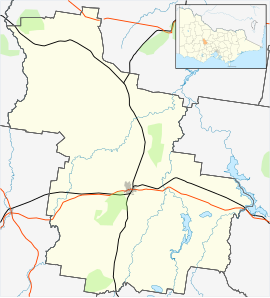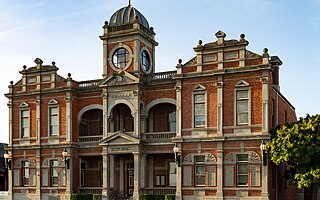
Castlemaine is a town in west central Victoria, Australia, in the Goldfields region about 120 kilometres northwest by road from Melbourne and about 40 kilometres from the major provincial centre of Bendigo. It is the administrative and economic centre of the Shire of Mount Alexander. The population at the 2021 Census was 7,506. Castlemaine was named by the chief goldfield commissioner, Captain W. Wright, in honour of his Irish uncle, Viscount Castlemaine.

The Victorian gold rush was a period in the history of Victoria, Australia, approximately between 1851 and the late 1860s. It led to a period of extreme prosperity for the Australian colony and an influx of population growth and financial capital for Melbourne, which was dubbed "Marvellous Melbourne" as a result of the procurement of wealth.

Avoca is a town in the Central Highlands of Victoria, Australia, 71 kilometres (44 mi) north west of Ballarat. It is one of two main towns in the Pyrenees Shire, the other being Beaufort to the south.

Homebush is a locality 10 kilometres (6 mi) from Avoca in central Victoria, Australia. It is located within the Pyrenees Shire.

Maryborough is a town in Victoria, Australia, on the Pyrenees Highway, 58 kilometres (36 mi) north of Ballarat and 168 kilometres (104 mi) northwest of Melbourne, in the Shire of Central Goldfields. At the 2021 census, the urban centre had a population of 7,769., while the larger Level 2 Statistical Area which includes the urban fringe, had 8,160, both an increase of more than 3% since 2016.

Moliagul is a locality in Victoria, Australia, 202 kilometres (126 mi) northwest of Melbourne and 60 kilometres (37 mi) west of Bendigo. The town's name is believed to be a derivation of the aboriginal word "moliagulk", meaning "wooded hill". The area is notable for the discovery of a number of gold nuggets. These finds include the world's largest, the Welcome Stranger, which was discovered in 1869 by John Deason and Richard Oates.
Adelaide Lead is a locality in Victoria, Australia, located on Old Avoca Road, 7 kilometres (4.3 mi) south-west of Maryborough, west of the Paddy Ranges State Park, in the Shire of Central Goldfields. Located on the northern slopes of the Central Highlands, the area is naturally characterised by Box-Ironbark forest. Remnants of Aboriginal settlement include rock wells beside Possum Gully Road.

The Pyrenees is a wine-producing region centred on the Pyrenees ranges located in Victoria, Australia near the town of Avoca.
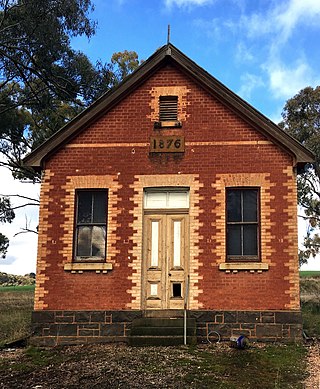
Bung Bong is a locality in Victoria between the towns of Avoca and Maryborough. The locality is divided, with the Western section in the Pyrenees Shire and the Eastern section in Shire of Central Goldfields. The Bet Bet Creek runs towards the north through the middle of the locality and then into the Loddon River. Bung Bong is located on the Pyrenees Highway.

Blackwood is a town in Victoria, Australia. The township is located on the Lerderderg River, 89 kilometres north-west of the state capital, Melbourne, within the Wombat State Forest. Blackwood is in the Shire of Moorabool local government area and had a population of 387 at the 2021 census.

Talbot is a town in Victoria, Australia. At the 2016 census, Talbot had a population of 442.

The Shire of Talbot and Clunes was a local government area about 160 kilometres (99 mi) northwest of Melbourne, the state capital of Victoria, Australia. The shire covered an area of 541.31 square kilometres (209.0 sq mi), and existed from 1915 until 1994.
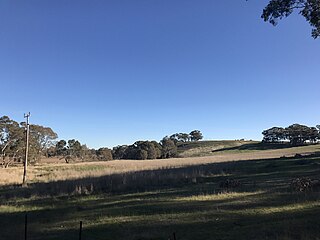
Muckleford is a locality in central Victoria, Australia. The area, also known as Wattle Flat, lies along the Muckleford Creek, a minor tributary of the Loddon River, approximately 127 kilometres north-west of the Melbourne city centre, and within the jurisdiction of the Mount Alexander Shire council. The nearest sizeable town is Castlemaine, approximately 7 km to the east. The original township is named after the English hamlet of the same name in Dorset, UK.

The Goldfields region of Victoria is a region commonly used but typically defined in both historical geography and tourism geography. The region is also known as the Victorian Golden Triangle.

Raglan is a town in western Victoria, Australia. It is located 177 kilometres (110 mi) north west of the state capital, Melbourne in the Shire of Pyrenees local government area. At the 2021 census, Raglan had a population of 223.

Timor (/ˈtaɪˈmɔː/), short-speak for the adjoining localities of Bowenvale and Timor, in the Central Goldfields Shire of Victoria, Australia. Their shared boundary is 8 kilometres (5 mi) north of Maryborough, Victoria and 178 kilometres (111 mi) northwest of Melbourne, the state capital.

During the Australian gold rushes, starting in 1851, significant numbers of workers moved from elsewhere in Australia and overseas to where gold had been discovered. Gold had been found several times before, but the colonial government of New South Wales had suppressed the news out of the fear that it would reduce the workforce and destabilise the economy.

Barkly is a locality in Victoria, Australia, about 180 kilometres (110 mi) northwest of Melbourne. It is near the intersection of the road from Landsborough to Redbank, and the road from Frenchmans to St Arnaud. It is close to the west boundary of the St Arnaud Range National Park. It is located in the Pyrenees Shire. At the 2016 census Barkly had a population of 43.
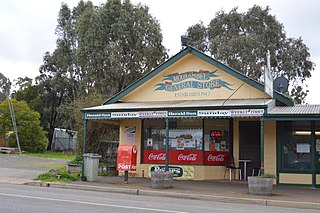
Moonambel is a town in the Pyrenees region of the Australian state of Victoria, situated along the Stawell-Avoca Road [about 8 kilometres (5.0 mi) from the junction with the Sunraysia Highway]. The town is located in the Pyrenees Shire Local Government Area, near the heart of the Pyrenees wine region. The name 'Moonambel' is believed to be an aboriginal word meaning 'hollow in the hills'.
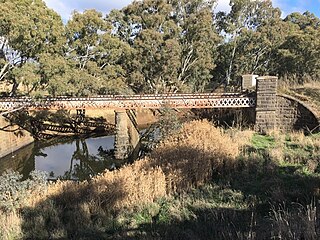
Bet Bet Creek in west Victoria starts below Ben Major, Victoria at an elevation of 479m and ends at an elevation of 165m flowing into the Loddon River at the Laanecoorie Reservoir. The Bet Bet Creek drops around 314m over its 87.8 km length and ultimately contributes to the Murray River system. The six creeks flowing into the Bet Bet Creek are: Moina Creek, Doctors Creek, Caralulup Creek, Timor Creek, Carmanuel Creek and the Burnt Creek.

